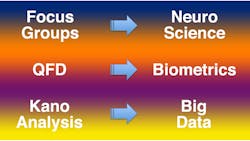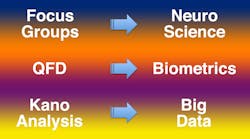Back to a Better Future: Product Definition
This file type includes high-resolution graphics and schematics when applicable.
During the 1970s, as Japanese companies began eroding traditional western markets, the focus was on Just-In-Time and other rapid-cycle logistics and manufacturing techniques. In the 1980s, efforts shifted to product development and “Stage-Gate” was born (Robert Cooper, Winning at New Products, 1986). Initially, the emphasis was on moving away from “throwing designs over-the-wall to manufacturing.” By the early 1990s, leading companies had achieved rapid cycle time. It became clear to industry leaders that the primary cause of poor cycle time was actually the product definition. Unless the product definition was robust, no amount of good engineering or organizational speed could turn an inadequate definition into a successful product.
Two studies were perhaps the most telling. The first was led by Hewlett-Packard and presented at the IEEE Engineering Management Conference by Edith Wilson in 1990. It laid out the top 10 most important factors for coming up with a good product definition. At the time, “product champions” were all the rage. Assign a product to a champion and all should work out fine. The HP study showed that it was much more complex than having a champion. In Pareto order, here are the 10 factors HP identified as leading to successful definitions.
• Understanding users’ needs
• Strategic alignment
• Competitive analysis
• Product positioning
• Technical risk assessment
• Priority decision criteria list
• Regulation compliance
• Product channel issues
• Project endorsement by upper management
• Total organizational support level
The idea of a champion was not wrong; there were just eight things more important. The second piece of telling research was published in California Management Review in the Winter 1990 issue. Ashok Gupta wrote that the primary inhibitor for teams developing products was “poor definition of product requirements,” cited by 71% of respondents. Shortly thereafter, Stage-Gate frameworks were modified to include a “formal definition phase” and an even earlier “concept capture activity.” Voice-of-the-Customer was then coined by Abbie Griffin in 1994 and, for most of the rest of the 1990s, companies focused on getting a good definition. Focus groups reigned supreme. They were the best tool available at the time, with honorable mentions to Quality Function Deployment (QFD) and Kano Analysis.
The product-definition era ended 15 years ago. As software and the internet began to take over the world (both easier technologies to iterate to successful outcomes), up-front planning started to take a back seat. As a whole, society began to change as well. Critical thinking was gradually replaced by rapid doing. As 3D printing grew, making iterations faster for leading companies that could afford the quite expensive equipment, competitive advantages could be maintained. Today, 3D printing is down the cost curve and is available to all companies and to individual Makers working out of their homes. The playing field is nearly level again. Everyone, large and small, can now quickly and economically make physical models. Soon, 3D printing will turn out saleable market-ready products. Where does that leave us? It seems we are about to go back to the future, defining the right product.
As we head to a future that emphasizes definition, science will be on our side. While focus groups will continue to have a place, scientific advances and big data will put product managers and designers in a better position to more accurately validate requirements up front. Biometrics and neuroscience, independently and together, are already showing their improved accuracy over the synthesized words and body language from focus-group participants. When enough data has been accumulated, statistical analysis of scientifically obtained big data sets will provide more accuracy than spoken words and body language. When the tools to gather scientific data and perform big-data analyses hit the broad market, up-front planning and analysis will again prevail because competitors in most industries will have essentially the same execution cycle times.
Looking for parts? Go to SourceESB.
About the Author
Bradford Goldense
Contributing Technical Expert
Bradford L. Goldense is founder and president of Goldense Group, Inc. [GGI] (www.goldensegroupinc.com), a consulting, market research, and education firm focused on business and technology management strategies and practices for product creation, development, and commercialization. He has been an adjunct faculty member of the graduate engineering school at Tufts University's Gordon Institute for 19 years. Goldense is a Certified New Product Development Professional [NPDP], a Certified Manufacturing Engineer [CMfgE], a Certified Computer Professional [CCP], and is Certified In Production & Inventory Management [CPIM]. He holds over 200 registered copyrights and is a recognized subject-matter expert, including appearances on PBS and CNBC. He has consulted to over 250 companies and over 750 manufacturing locations on four continents since founding GGI in 1986. Goldense holds an MBA in Accounting from the Cornell Johnson School and a BSCE from Brown University. For more information, please see Brad's LinkedIn profile or visit GGI's home page.


